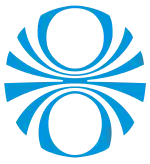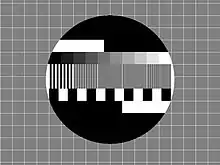RÚV (TV channel)
RÚV1 (formerly known as RÚV Sjónvarpið (English: 'RÚV The TV') prior to 31 March 2011) is the television channel of RÚV, the Icelandic National Broadcasting Service, launched in 1966. The channel broadcasts primarily news, sports, cultural programs, children's material, American, British and Nordic films and entertainment programming. Among its highest-rated programs are the comedy sketch show Spaugstofan (moved to Stöð 2 since 1989) and Fréttir (News).
 | |
| Type | Broadcast television channel |
|---|---|
| Country | |
| Availability | National; also partially distributed over the Internet on Thor 5 and Worldwide |
| Owner | RÚV |
Key people | Magnús Geir Þórðarson, CEO |
Launch date | 30 September 1966 |
Former names | Sjónvarpið (1966–2011) |
Official website | www.ruv.is |
History

The network made its first transmission on 30 September 1966. To begin with, transmissions only took place on Wednesdays and Fridays, only gradually expanding to the rest of the week through the years, but there were no transmissions on Thursdays.[1] In addition, no television was broadcast in July.[2] Transmissions in July began in 1983.[3] Sjónvarpið was the first public television channel in Iceland and also the first to broadcast in the Icelandic language, although Armed Forces Radio and Television Service Keflavik (is) broadcast an English language television service from Naval Air Station Keflavik from 1951 until the latter's closure in 2006. Having lost its monopoly and sharing the market with Stöð 2 a year before, Sjónvarpið ended the era of television-free Thursdays on 1 October 1987, resulting in the first full week of television in Iceland.
Test colour transmission commenced in 1973 and started full-time in 1976. From September 1981 onwards, the channel greatly benefited from Iceland's connection to the rest of the world via satellite. Starting on March 1, 1982, Icelandic television viewers were able to watch daily reports from abroad on their evening newscast. Live broadcasts from the rest of Europe, such as the Eurovision Song Contest, commenced for the first time in May 1986. RÚV's teletext service, Textavarp, was inaugurated on the 25th anniversary of Icelandic television in 1991.
As late as 2000, television only aired for 8 hours each day, starting at around 4:35 pm and ending at around 12:35 am on weekdays. The number of hours of television aired per week changes every week and day, with transmissions during the weekend being the longest. RÚV currently starts at 7 am on Saturdays and Sundays. During the week, however, transmissions still start between 3 pm and 5:30 pm and end between midnight and 1:30 am. During downtime, the station carries its daily schedule and a news ticker, complete with audio from Rás 2.
Test cards

From the inauguration of Sjónvarpið in 1966 until as late as 1982, an electronically generated, heavily modified version of the Philips PM5540 monochrome test card was utilised during off-air hours, with the words Ríkisútvarpið SJÓNVARP occasionally appearing in the top and bottom black segments respectively.[6][7] In the early-1970s, the Philips PM5544 test card was introduced for colour transmissions and gradually replaced the previous monochrome test card, with the time and date included in the PM5544 test card from 1995–2000 and again from 2002–2006. In 2009, the Philips PM5644 widescreen test card was introduced to replace its PM5544 forerunner. In 2011 the test card was discontinued when an overnight filler programme similar to ITV Nightscreen was introduced during RÚV's off-air hours.
High Definition
In 2012 two new 1080i play-out systems were installed.[8]
On 27 March 2013 RÚV signed an agreement with Vodafone Iceland to install and run two new digital HD channels starting in 2014 that will transmit both over the air on UHF in 1080i and via IPTV systems of Síminn and Vodafone Iceland. Analog TV transmissions ceased in February 2015.[9][10]
Current Programming (as of May 2020)
Game Shows
Mini-series
- Jóladagatal Sjónvarpsins, an ongoing series of televised Advent calendars.
Special events
- Áramótaskaupið, a New Year's Eve comedy special with an audience of up to 90% of viewers
Animation
- The Adventures of Hello Kitty & Friends
- ALVINNN!!! and the Chipmunks
- Bob the Builder (2015)
- Clangers
- Corneil & Bernie
- Curious George
- Fireman Sam
- Go Jetters
- Grizzy and the Lemmings
- Hey Duggee
- Hurray for Huckle!
- Kid vs Kat
- Louie
- Mickey Mouse Clubhouse
- Molang
- Mr. Bean (2002)
- The New Adventures of Winnie the Pooh
- Nowhere Boys
- Paper Port
- PAW Patrol
- Peg + Cat
- Ronja, the Robber's Daughter
- Sarah & Duck
- Shaun the Sheep
- The Smurfs
- Top Wing
Children's Shows
Documentary
Drama
Entertainment
Factual
Science Fiction
Sitcoms
Sketch Shows
Special Events
Past Programming
Children's Shows
Comedy
Mini-series
- Sigla himinfley, a 4-part drama mini-series
Animation
- The Adventures of Tintin
- Alfred J. Kwak
- The Amazing World of Gumball (Season 1 & Season 2 Only)
- Bobobobs
- Boo!
- Bubble Guppies (season 1)
- Caillou
- Canimals
- Cédric
- Count Duckula
- The Deep
- Donkey Kong Country
- Duckman
- Fanboy & Chum Chum
- The Garfield Show
- Goof Troop
- Hamtaro
- Horrid Henry
- Kate & Mim-Mim
- Kirby: Right Back at Ya!
- The Little Prince
- Maisy
- The Marvelous Misadventures of Flapjack
- The Morph Files
- Once Upon a Time...
- Paddington Bear
- Pat & Mat
- PB&J Otter
- Peter Rabbit
- Phineas and Ferb
- Pingu (monaural)
- Planet Sheen
- Pokémon
- Poppy Cat
- Postman Pat
- The Powerpuff Girls
- Raa Raa the Noisy Lion
- The Ren & Stimpy Show
- Rotten Ralph
- Simon
- The Simpsons
- The Smurfs
- Sonic X
- Teen Titans
- Timmy Time
- Timon & Pumbaa
- Tom & Jerry Kids
- Tree Fu Tom
- Wallace and Gromit
- Wisdom of the Gnomes
Children's Shows
Comedy
Documentary
Drama
- Alias
- Below the Surface
- Brothers & Sisters
- Columbo
- Criminal Minds
- Dicte
- The Eagle
- ER
- Fortitude
- Heartbreak High
- In Plain Sight
- Jamie Johnson
- The Killing
- The Legacy
- Lost
- Modus
- Murphy's Law
- The Musketeers
- Occupied
- Once Upon a Time
- Private Practice
- Revenge
- Riviera
- The Saint
- The Sopranos
- Spooks
- Ultimate Force
- Vera
- Veronica Mars
Science Fiction
Sitcoms
Sketch Shows
Soap Operas
See also
- List of Icelandic television channels
References
- The American-Scandinavian Review, Volume 58, Henry Goddard Leach American-Scandinavian Foundation, 1970, page 72
- The Horn Book Magazine, Volume 47, Bertha E. Mahony Miller, Horn Book, Incorporated, 1971, page 465
- Guinness World Records 2015, Guinness World Records, page 174, 2014
- https://plus.google.com/photos/110075467441072153682/albums/5720743420927143969
- https://www.fmtvdx.eu/radiobulletin/europesche-testbeelden.html
- https://web.archive.org/web/20190111033934/http://www.radios-tv.co.uk/Pembers/Test-Cards/Non-UK.html#Iceland
- https://www.nordvision.org/nyheter/nyhet/icelandic-tv-at-50/
- Farbwahl GbR. "ATG Broadcast Completes High-Definition Expansion for RUV, Iceland". live-production.tv. Retrieved 7 March 2015.
- "Tvær stafrænar háskerpurásir verða hjá RÚV". RÚV. Retrieved 7 March 2015.
- "Archived copy". Archived from the original on 2013-07-09. Retrieved 2013-07-12.CS1 maint: archived copy as title (link)